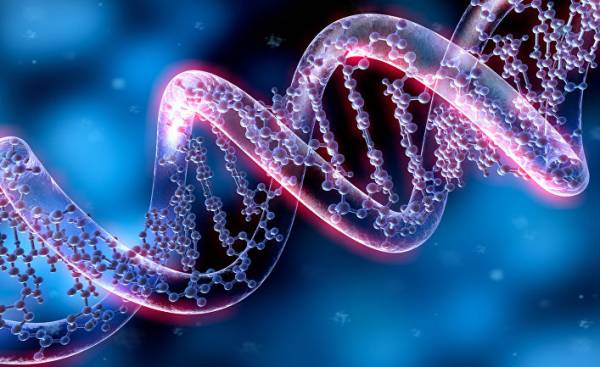
Sergei Medvedev: When I was a child and young man, I remember how the Newspapers constantly trumpeted: that’s something, when decode the human genome when all these bricks and the bricks becomes clear… And that the human genome is transcribed — then what? Appears science called “bioinformatics”. What is it? Is the human genome a certain designer, LEGO from which to create human life? Our guest is Mikhail Gelfand, bioinformatic, head of the master program “Biotechnology” of Skoltech, Deputy Director of the Institute of information transmission problems, Russian Academy of Sciences.
Michael Gelfand: I’m a Professor in the Department of computer Sciences of the Higher school of Economics and faculty of bioengineering and bioinformatics, Moscow state University.
— As I understand it, in the genome of three billion letters. We know the code — what can we do with this code? This kind of cookbook life, we now can prepare a person, the homunculus out of the tube?
Is the cookbook of life in the sense that life is able to replicate itself on the recipes contained in this book. We do not know, we are in this sense a bad cook.
Generally, this metaphor of decoding and reading of the genome is not very good, because decoding involves understanding, but we still understand quite poorly. The molecule of heredity, DNA, which was in the living cell, and then in vitro, we have learned to reproduce in the computer, we know in what order these letters are combined in this molecule. But the meaning is a little bit different thing.
Bioinformatics has emerged as an independent science exactly when biology gradually began to turn from science, working with separate objects, in science, in which a lot of data. At this point, there is a need to store, comprehend, analyze these data and something to do with them.
Is approximately what years?
In 1977 he developed methods for sequencing DNA (I specifically say, not “decrypt”, and “sequencing”). Bioinformatics began to emerge, probably in the early 80s. I was lucky when I in 1985 he graduated from the University, it was such a wonderful area where you should not have anything to teach, she started from scratch, you can just take and to do. So very rare in history.
Is it more common to apply mathematical methods?
— The methods it mathematical in the following sense: to think it is necessary. There in some places there are beautiful algorithms, nice stats, but, in principle, mathematics there is quite trivial, no mathematical magic wands there. You need a skill to keep in mind a lot of things and try different ways to explain and second skill to ask simple questions. It is in this sense I found it very useful mathematics education, not so much, maybe education, how to communicate with my grandfather Israel Moiseevich Gelfand, who was a mathematician and worked very much in experimental biology.
— Now recorded in the genome, determined by the sequence — what can we do? I heard there’s a new technology: we can take some chain genes and to fix it, insert instead good. That is, we can operate with these letters?
— CRISPR is a technique of genetic engineering, one of the very advanced, very modern technology which allows to make very precise and specific manipulation.
People simply have more possibilities. In principle, to insert and remove genes people were able before, just it was harder experimentally, not all manipulations were technically feasible. Now expanded set of tools. It was possible to build a home in Sparta, only with an axe and now I have a saw and even a jig saw, you can cut some beautiful trim. In this sense, technological progress is very large, but not very informative. Some things we understand that there is a simple monogenic disease, in which broken a single gene — it is clear that if you can fix it, it will be a normal embryo.
It is already treated?
— No, it is not treated, it is impossible to manipulate with human embryos — it’s just prohibited by law.
But, as I understand it, it moves. In England allowed with embryos up to 11 days…
— In China even ask, no one will. You can’t slow down the rink, placing it turtles: turtles it’s a pity, but the rink will be nothing. In this sense, of course, it will move, but the humanity necessary to comprehend it. This is a serious problem that requires understanding.
She’s not the first. When in the mid 70-ies has just begun genetic engineering, when it became clear that the genomes can be manipulated (bacterial), it was already a serious problem: for example, feared that the accident will make some superbacteria, and all she will eat. Was a special conference where they developed the rules that we do, and what not to do. Just a new set of tools expands capabilities, increases accountability, and it needs to be comprehended.
— Raises ethical questions…
— And if we talk about bioinformatics, returning to what you asked, then there’s a little bit different story. There are two aspects. It turned out that we can answer quite a few classical biological issues in the computer.
I do a lot of genomics of bacteria. There are so many bacteria, with which their life was made one experience, namely, determined the genome sequence. We about them know quite a lot: what they eat, what cannot eat, how they breathe, what they need to add to your environment, without which they cannot survive, and you can not do yourself, and so on.
— How much simpler genome of the bacteria compared to the human genome?
Is not so critical. We have E. coli 30% of the total genes. The number of genes in a typical bacterium is thousands, and the man — 25 thousand.
— You completely know which gene is responsible for what bacteria?
— Not entirely, but know a lot.
Much more than a person?
— Percentage of course.
The second thing that appeared (and this, again, is due to technological developments in experimental biology) and requires interpretation in bioinformatics, is that we can look at the cell as a whole. Classic stuff: graduate studies some protein, he knows, this squirrel knows how this protein interacts with DNA, if he interacts with it, knows when switched on and when switched off the gene for this protein. It’s such a full dissertation, several scholarly articles about one protein. And then there are methods that allow to answer the same questions for all proteins at once. We appears for the first time an integrated picture of how the cage; she is now very imperfect.
— There is a protein that is unfamiliar to you, but you can predict, looking at his genome…
— These are two different issues. We can predict functions of proteins, making them no experiments. This is a beautiful bioinformatics based on any evolutionary considerations.
— Based on his genetic profile?
Protein is that encoded in the gene, so it is better to talk about the gene: based on what this gene lies nearby, to whom this protein is similar already at least a little known on how it is regulated when it is switched on and off.
The same thing probably can be done about the man?
— It’s harder. Technically — you can.
— Look at the genome of some human embryonic and say, grow up a genius or grow Down.
Is the story about the fact that the function of a protein is generally unknown, about it knew nothing, and we can predict. And what you say, it is a well-known set of proteins, but with some variations — is a little bit different story.
— Man is composed of known proteins.
Partially — known, partially — not. It turned out that we have a lot of heterogeneous information about how to construct the cage. Information is very imperfect, every single tiny fact could easily be wrong, but collectively they are still correct. And from this you can try to describe the cell as a whole.
Molecular biology very long criticized the philosophers for what is a reductionist science. Here you see an elephant on someone is examining the leg, some the tail, some the trunk, and no coherent images are not formed. Now she first begins to take shape. One of the paradoxical results of this is that our knowledge and understanding in an absolute sense increase very quickly. In biology, the progress is amazing: we know a lot more than we did 10 or 20 years ago, even at times, and orders of magnitude more.
But even the faster growing region of ignorance. That is relative, our knowledge really is, in my opinion, decreases, as it becomes clear that there are such spaces, which ten years ago we just never occurred that it happens. And now we see that it is, but don’t know what to do with it. That’s scary cool.
Who’s going Down is clear: an extra chromosome. But who will and who will not be a genius, we can not predict, and the glory of God. Even the growth we do not know how to predict.
The accumulation of this information?
— There is, of course.
— Is it possible, say, to compare the behavior of man, his social profile with his genetic profile?
— About it I don’t know, but psychological traits is determined in part by the genome, and they can be a little predictable.
Partial genome, partly by the society.
— Society, some life circumstances… In genetics is designed thing you can quantitatively estimate the contribution of genetic factors to a particular trait. Let’s take one person — me. I have all the cell genomes of the same, but the cells I have are different.
— That is, at some point the genomes of understanding of what the cage for them to grow?
— At some point, the cell realizes that it must be the predecessor of the epithelium or nervous system, or liver, or something else. After the first divisions of all cells of the same genes in them work equally, and then begin to work differently. The key thing really — not the genes themselves: me and the chimp 50% of proteins are identical, and those that are different, differ by one letter.
— So the question is, where is the program at some point tells the cell that it needs to develop into a man or in the chimpanzee and in man in the brain or in the liver.
— It is there, in the genes, but the key thing is not the genes themselves, but how they turn on and off. And that’s the most exciting thing happening in biology.
— Is there a program that turns on and off?
— Of course. In fruit flies is well known. Simple Drosophila, the embryo she’s too simple… No, the Drosophila complex, but the early stages of its development are very well described it quantitatively in the models. For example, you can predict the results of mutations. There are mutations, when in fruit flies instead of the mustache grows a leg. It is known, in which a gene mutation that is broken, and it is possible to simulate — as mistaken progenitor cells.
— And it is possible to fix it with new technologies?
It is possible, but only the embryo. When he grew up a leg or an extra pair of wings, not fixed.
— What it can bring in a practical sense? For example, what interests each person, the cancer C… this stunning CRISPR technology, the Chinese seem to be trying to fight lung cancer. As I understand it, this technology bacteria when she sees the broken fragment of DNA, takes a piece of healthy bacteria and replaces broken chain healthy.
— Yes, but the interesting question is what happens with healthy bacteria… No, not so. CRISPR/Cas-system is a bacterial immune system, a little bit different thing. When the bacterium infects a virus if he didn’t manage to kill her, there starts the war, the virus switches any bacterial system that breaks down the bacterial genetic programme and switches the bacterium to produce new viruses. In fact, all viruses do: and bacterial, human, and whatever. There is a system that allows bacteria, if the virus managed to kill her in the beginning, you cut a piece of virus DNA and used as a sample for the next attack of the same virus.
The bacterium itself instills this virus.
In a sense, Yes. And then it turned out that there is a protein that is able to cut a piece and purposefully somewhere to paste, and you have this same enzyme can be used for the purpose of genetic engineering.
About a cancer therapy I do not really understand that when you have billions of cells, how are you going to each of them to build the right system? I don’t understand how this is technically done. This can be done for the treatment of genetic defects in the embryo stage, when there is one cell.
Cancer story is a bit different, there is really very significant progress. It became clear that what we took for the same disease, it is actually at the molecular level, different diseases, and targets for therapy must also be different. Cancer first classified just the place: had lung cancer, stomach cancer, skin cancer. Then came the histology. When they began to look at the structure of the tumor, from which cells it is composed, began diagnoses of the type “small cell lung cancer”. Then came biochemistry, began to look at some markers, it has fragmented even further.
And now we can see what actually happened mutation. You take a sample from a cancerous tumor and a sample from the same normal tissue, and see how they differ. They are very different, because cancer all breaks down, errors start to accumulate very quickly. There is a special term — “drivers” and “passengers”-some of these errors — passengers, they had an accident, and some were drivers, they are, in fact, led to degeneration.
There used a completely practical thing, because, for example, it is clear that some cancers that are considered the same disease, should be treated differently. Conversely, if you have externally different cancers, but they have the same molecular breakdown, you can medication, effective against one, to attempt to use against another.
Is the failure at the genetic level, broken some sort of gene?
Or embossed, or, on the contrary, began to work too intensively. A typical symptom of cancer — when the genes that work on the embryonic stages, begin to work in adult tissues. These cells start to divide uncontrollably. Many cancers is actually the degeneration, degradation back in time.
I just want to emphasize that I am not a doctor, I know about it as a biologist and a man, a little reading the reviews. I’m really afraid of disappointing people. There is always a balance between success in science and practical question — for those who tomorrow to go for treatment. This is experimental stuff. There are a few example of when it worked. But it is clear that in this direction it will happen.
— If you look at the medical use, you see that will have genetic engineering, gene therapy? Now, as I understand it, on a separate autoimmune diseases can be seen that any one gene is broken.
— It is, rather, a defect of the immune system, knocked out the immune system. It is trying to heal.
— Immunodeficiency at the genetic level?
— This is because the nature of the immune system. There the cells divide all the time, all the time there are new clones. Even if you have all the defect, but you made a small fixed number of progenitor cells, they can replace the entire immune system to produce it again. This has to do with the specifics of how all is arranged in the immune system. It is amazingly plastic.
— The bacteria created a vaccine, the immune system?
— Yes, but there’s a little bit more. Again, when talking about the immune deficiency, this means that there are no classes of cells, because the gene is broken, which should work when these cells Mature. If you mend this gene in some predecessors, they will ripen in these cells, they give rise to all immune this big picture.
— There is still, as I understand it, computational evolutionary biology. You can revert back and watch the gene of ancient man?
Is almost the most interesting. Bioinformatics is not a science in the same sense in which it is not electronic microscopy, is a set. The science of bioinformatics, it is, first, something to do with the biology of development, and secondly, that molecular evolution, and there you can do different wonderful things.
We much better understand how it happened. Our differentiation from mouse start on the first stages of the embryo, and then everything is fixed. The same genes worked a little bit in different combinations. This dream to describe a variety of animals by understanding how they arose, there is more of a Haeckel. Haeckel much manipulated, for which he was criticized, but the idea itself is very correct. To understand the difference between man and mouse, we must look not an adult and the adult mouse, and the embryos in the first stages. It now becomes real.
The second thing: we understand who’s related to who, just by comparing genomes. It is clear that the smaller the difference, the closer the relationship. This is a very simple idea, it can be algorithmization. Our understanding of the evolution of living beings in General pretty much changed. Traditionally mushrooms have always studied in the Department of lower plants, and in fact, mushrooms are not any lower plants, and our closest relatives. Us mushrooms flowers, a cousin. From this it follows that mnogoletnei has arisen many times independently, and this is a very fundamental question. When we were in school, was bacteria, then there was the simplest, simplest and then began to stick together and get multi-celled and then multicellular organisms are divided into plants and animals. There were some lower plants, fungi, and higher plants — roses and buttercups. And in fact, not so: there were many different single-celled, and in these different lines of single-celled several times independently any mnogoletnei.
Man as the highest form of mnogoletnei?..
I don’t know in what sense the highest. If you look at the variety of fabrics, all mammals are the same price. If you look at the complexity of the nervous system, we need to compare with octopuses. But if someone it’s nice to be antropocentrism the health, I don’t mind.
Our understanding of the origin of man has changed very much. Each of us have 2% Neanderthal, and the Denisova (Denisovskoe people), about which nobody suspected. In fact, in Eurasia 40 thousand years ago, there were three independent branches of humanity, they were crossed in all combinations, and the remnants of these crossings we see in the genome.
Is you take all the remains of what was left in the Parking lots?
Is the old DNA and the analysis of modern DNA from different people. I think it’s very cool. It is very much skewed picture.
— Michael, you threw us. 2% Neanderthal, but a lot in common with mushrooms, flowers… Really, we’re talking about cubes, of which life works. Now, as I understand it, you combine these blocks in a different order, see which signs occurred in ontogenesis and in phylogenesis, the evolution of the embryo of the individual, as all evolved life on Earth.
Yes. We do this in the computer, and the experimenters are doing in the cells.
We live in an amazing time! We hope that these experiments will lead to the development of drugs against cancer and AIDS.
— Actually, the cure for cancer has been created.
— I mean the understanding of mechanisms of action.
And with a diagnosis of AIDS people live and live in modern medicine.
— The question is not about medications, but to treat it genetically. This further wish.







